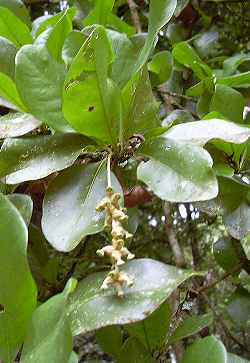Black Olive
Scientific Name: Bucida buceras L.
Synonym: Myrobalanus buceras, Terminalia buceras
Family: Combretaceae

Bucida buceras, flowers, Photo by Forest & Kim Starr, starr-030807-0066
Sunset®: 25
USDA: 10b-11
Frost Tolerance: Killed at 25°F (-4°C), damaged at 32°F (0°C)
Sun Exposure: Full sun to part shade
Origin: West Indies
Growth Habits: Evergreen tree, dense foliage, rounded crown, slow growing to 40 to 50 feet tall (12-15 m), 35 to 50 feet wide (9-15 m); spiny stems; dark bluish-green, obovate leaves 2 to 4 inches long (10 cm)
Watering Needs: Moderate water, drought resistant, salt tolerant
Propagation: Layering, seeds (difficult)
The Black Olive can be messy, dropping leaves, flower debris and seed pods. It should be planted away from concrete as its fruits will stain and its roots will uplift sidewalks and pavements.
Blooming Habits:
Small, greenish-ellow, odd smelling flowers, 0.25 inch long (6 mm), very attractive to bees, in spikes, 3 to 4 inches long (7-10 cm), during spring and summer. The flowers are attractive to bees.
Fruiting Habits:
Oval, black capsule, 0.25 to 0.5 inches long (6-12 mm)
Desert-Tropicals is dedicated to provide gardening advice, gardening ideas, and information about flower of all kind for landscape and collections.We try to check carefully the identification of the plants on the illustrations as well as the other information from the page, but occasionally errors do occur. if you notice anything that needs to be changed please contact us.Thanks.
© 1998-2020 Philippe Faucon, All Rights Reserved.